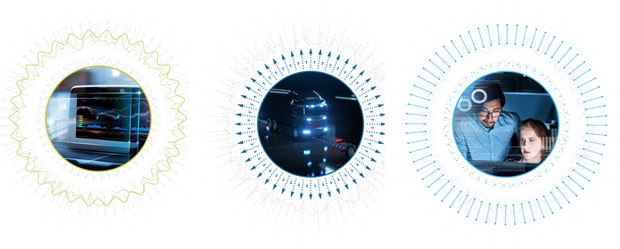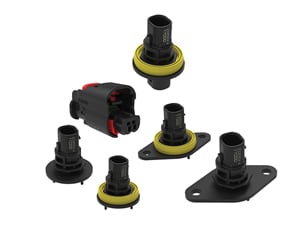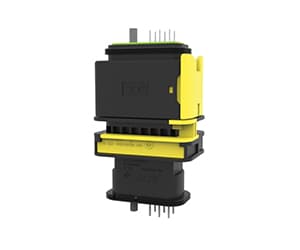
Trend Insight
Enabling the Next Generation of Heavy-Duty Vehicles
Discover the considerations we took to design our Ethernet connectors for heavy-duty vehicles.
AUTHOR
By Joachim Barth, Manager, Product Development, Data Connectivity, and Christian Manko, Data Connectivity Product Manager, TE Connectivity
Ethernet Connectivity for the Changing Industrial & Commercial Vehicle Landscape
As heavy-duty vehicle manufacturers strive to keep up with rapidly changing regulations and customer demands for safer, greener, and more productive vehicles, they are realizing that CAN bus networks simply cannot support the increased data connectivity required for advanced functionality. Single-pair Ethernet protocol with speeds of 100 Mb/sec (100BASE-T1) or 1 Gb/sec (1000BASE-T1) is becoming more important for heavy-duty vehicle designers as advanced functionality demands and data needs continue to increase.
Industrial and commercial transportation manufacturers are relatively new to this protocol, and product development specifically for Ethernet components for this market has been limited. However, the industry does benefit from the fact that the automotive industry has been incorporating Ethernet in passenger vehicles since 2005. Heavy-duty vehicle designers can use Ethernet connectors from both the automotive industry and those developed specifically to withstand the harsh environments of industrial and commercial job sites such as in construction, mining, and agriculture.
Applying Automotive Ethernet
Using Automotive Ethernet Technology in Commercial Vehicle Applications
As industrial and commercial vehicle designers look to upgrade the connectivity systems and networks in their vehicles, many high-speed data applications can be designed using connector technology that has been developed over the past several years for use in the automotive industry.
Designers of passenger vehicles and light-duty trucks have been using Ethernet networks and components to enable features such as diagnostics, in-vehicle infotainment, rear- and side-view camera systems, adaptive cruise control and more. Using Ethernet enables more bandwidth to satisfy the ever-increasing need for more data. As advanced driver assistance systems (ADAS) and other automated functions become more prevalent—leading eventually to full autonomy, requiring radar, lidar and more sensors—designers must incorporate Ethernet networks to be able to manage the data connectivity needs of today and the future.
Heavy-duty vehicle designers may choose automotive Ethernet connectors in places not exposed to the elements or extreme shock, such as in the cabin where more ruggedized connectors and longer-length cables are not needed. This will also help control costs and save space and weight.
For example, our MATEnet connectors were originally developed for IEEE Automotive Ethernet Networking. MATEnet connectors are modular and scalable and can be used in different configurations like multiport or sealed/shielded applications. They can be used for ADAS sensors, 360° camera systems, telematics units, onboard diagnostics, infotainment applications in the dashboard, and other similar applications requiring mid- to high-size data volumes and low latencies. Our MATEnet connectors are capable of data transmission rates from up to 100 Mb per second to up to 1 Gb per second, according to IEEE 100BASE-T1/1000BASE-T1, and the connectors can be used with unshielded or shielded twisted-pair cables. MATEnet interconnections rely on the proven NanoMQS terminals, which are automotive-grade miniaturized contacts that offer high robustness against vibration.
Having over a decade of experience in automotive Ethernet applications as well as engineering expertise in sensors and the industrial and commercial transportation sector as we do at TE, can be valuable to manufacturers in the early design stages. Our engineers and product experts work together to help OEM designers outline the architecture of the vehicle to optimize weight, space, and cost by only using Ethernet where needed and using automotive Ethernet connectors in ideal areas to enable high-speed data processing for advanced functionality customers to demand.

Developing Ethernet products
Considerations for Developing Ethernet Products for Heavy-Duty Vehicles
The environments and challenges that industrial and commercial vehicles face can be much harsher than what passenger cars and light-duty trucks experience. Plus, the size difference alone creates more challenges for signal integrity for Ethernet applications. In a car, the greatest distance an Ethernet signal has to travel is 15 meters. In heavy-duty vehicles in on-highway trucking, construction, mining and more, signal integrity must be maintained for longer lengths, up to 40 meters, while withstanding those harsher conditions.
In cars, sensors and camera systems that provide real-time views for safety or automated functions typically only have to work on streets without many obstacles and where patterns and terrain stay similar. In construction and agriculture vehicles, such systems would need to discern much more. The systems need to be able to view, sense and transmit data that can assess whether something on the ground is a stick, a rope, a steel pipe or a cable, for example—something harmless to run over versus something that could potentially cause a safety risk or damage the vehicle. In this case, cameras and sensors with higher definition or multispectral sensors would be needed. More advanced functionality like this and more would rely on 1Gb/sec Ethernet.

The sensors, cables, and Ethernet connectors for these heavy-duty vehicles must be rugged and robust enough to handle the harsh environments both outside and inside the chassis. They need to be designed for applications where dust, dirt, moisture, extreme temperatures, and high vibration are common. Ideally, they also need to be field serviceable.
In product development, functional safety needs to be a foundational thought for designers from the beginning stages of design. With automation, much basic driving and automatic functions on the vehicle become safety-related so that there is less risk to drivers, other personnel on worksites, and other cars and light trucks on highways. The probability of system failure must be kept to a minimum, and if a failure occurs, the system must enable the vehicle to respond appropriately. Manufacturers’ design, quality management, and development processes need to keep these safety concerns at the forefront.
Manufacturers who solve these challenges will give their customers a competitive edge as the new Ethernet networks and connectors allow them to seamlessly integrate more devices onto the network and accelerate data connectivity in their vehicles, boosting safety and productivity for the end-users.

New Ethernet Connectors for Harsh Environments
Currently, rugged Ethernet connectors for industrial and commercial vehicles can be found in two categories—for applications transmitting data up to 100 megabits per second and for applications requiring data transmissions of up to 1 gigabit per second. In some cases, Ethernet connectors designed for the industrial and commercial vehicle industry use an automotive connector as a base or are an extension of a series originally used for passenger vehicles.
At TE, we paired our automotive MCON terminals with more robust housings and upgraded the design to meet the 100BASE-T1 specification creating a new sealed Ethernet connector called enetSEAL+. This new generation of enetSEAL+ connectors is capable of up to 100 Mb per second of data connectivity and provides robust, full-duplex, wire-to-wire connections for multifunction displays, telematics, telemetry units, infotainment modules, and media access controllers. They can be used to connect external cameras and sensing modules to improve operator situational awareness and enhance safety using Ethernet differential signal transmission communication protocols. Importantly, for the heavy-duty vehicle market, the sealed enetSEAL+ connectors are also fielded serviceable.
Other features include:
- Optimal, high-quality design helps reduce manufacturing and service costs.
- Sealed for dust and water resistance per IP67 and IP69 (with backshell) ratings.
- Multi-contact point technology for higher reliability.
- Built-in secondary locking feature is designed to secure contact retention.
- Modular application is possible with two codings and multiple panel thicknesses for passthrough or ECU applications.OEMs can use the existing harness maker supply chain.


Our Heavy Duty Sealed Connector Series with MATEnet Inserts is a rugged, heavy-duty thermoplastic connector that is capable of data transmission rates of up to 1 Gb per second. It is compatible with TE’s MATEnet interconnection system and provides wire-to-wire and wire-to-device connections. It’s designed to perform in the toughest environments and offers heavy-duty vehicle designers flexibility to implement multiple hybrid interfaces and scalability by using unshielded or shielded twisted pair cables.
Benefits of our Heavy Duty Sealed Connector Series with MATEnet Inserts include:
- Optimized to improve long-term use reliability, reduce manufacturing and service costs.
- Connection secured with the built-in secondary locking feature for contact retention.
- Clear handling, the low mating force with reliable slide locking mechanism delivered in pre-locked position.
- Designed with the modular application in mind for wire-to-wire and wire-to-board allowing several mounting options: inline, sealed flange, and PCB mount.
- Sealed for dust and water resistance per IP67 and IP69 (with backshell) ratings.
Both solutions adapt to virtually any harsh environment application including radar, lidar, cameras, telematics units, onboard diagnostics, head-up displays, instrument clusters, infotainment applications, and Ethernet architecture.
Design Goals by Experts
Using Ethernet Communications Experts Early in the Design Phase
The goal in design is to stay ahead of technology trends, especially when designing long-lifetime vehicles. To stay competitive in the market and ahead of automation trends and functionality that satisfy customer demands for increased safety, productivity and sustainability, manufacturers must incorporate Ethernet in all their latest designs to be able to handle the increased data connectivity requirements of today and the future. Because Ethernet is relatively new in the industrial and commercial transportation space, it’s important to consult early on with engineers and product managers who have expertise in designing Ethernet and other communication protocols across the automotive, trucking and heavy-duty vehicle industries.
At TE we have extensive application and system expertise across automotive, industrial and commercial transportation, and data communication industries. Our engineers and product experts work closely with customers to advise on the topology and technology needed to design in advanced functionality that requires increased sensing and computing power while maintaining signal integrity in harsh conditions. We are an established leader in this market, leveraging our experience and proven performance in high-speed data and reliabilities in extreme environments to design and manufacture the essential terminals, connectors and cables which make robust vehicle Ethernet networks possible.
To Learn More About our Solutions for Connected Vehicles

Autonomous Driving
Ethernet Solutions
Learn more about the connectivity requirements to enable commercial and industrial vehicles autonomous driving.

Data Connectivity
Heavy-Duty Vehicles Solutions
Discover why design engineers must consider incorporating Ethernet systems in their industrial and commercial vehicles and machinery to meet future customers' needs.

Connected Vehicles
Harsh Environment Requirements
Learn why the components, their placement, and the impact of environmental conditions must be considered at the early stage of your vehicle design to ensure high-speed data transmission.
Originally published in ATZheavy duty worldwide

